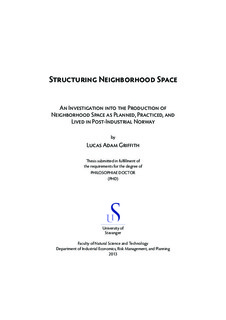| dc.contributor.author | Griffith, Lucas Adam | |
| dc.date.accessioned | 2014-03-10T11:05:19Z | |
| dc.date.available | 2014-03-10T11:05:19Z | |
| dc.date.issued | 2013-06-19 | |
| dc.identifier.citation | Structuring neighborhood space : An investigation into the production of neighborhood space as planned, practiced and lived in post-industrial Norway by Lucas Griffith, Stavanger : University of Stavanger, 2013 (PhD thesis UiS, no. 198) | nb_NO |
| dc.identifier.isbn | 978-82-7644-538-1 | |
| dc.identifier.issn | 1890-1387 | |
| dc.identifier.uri | http://hdl.handle.net/11250/191426 | |
| dc.description | PhD thesis in Risk management and societal safety | nb_NO |
| dc.description.abstract | Daily life has subsumed a multiplicity of city environs and appropriated urban
space as the stage for everyday life while global forces have reciprocally
subsumed the city as an economic space for the investment of accumulated
capital and restructured urban space as a global phenomenon. On the one hand,
daily life has expanded beyond the traditional conceptualization of nearness and
appropriated the city as an everyday space. And on the other hand, capitalism
has expropriated the city as part of the global market and altered the space in
which everyday life is practiced. The relationship between these two polarization
of urban space is the focus of this inquiry. The research specifically explores the
subject of neighborhood as situated within this paradoxical dualism, analyzing
the production of neighborhood space as informed by urban development and
daily life.
The research examines the social forces structuring contemporary neighborhood
space, specifically, asking how development practices produce neighborhood
space as an architectural phenomenon and conversely, asking how daily life
appropriates the physical space of nearness as an everyday phenomenon and
structures the identity of place. As daily life continues to expand beyond the
neighborhood and global markets continue to produce urban form, how is
neighborhood space structured?
The question is purposefully structured as a dualism to reflect the structuralism
of global society and the agency of everyday life. The research examines urban
space as both created by the capitalistic processes operating on the city and by
the people living everyday life within the city. | nb_NO |
| dc.language.iso | eng | nb_NO |
| dc.publisher | University of Stavanger, Norway | nb_NO |
| dc.relation.ispartofseries | PhD thesis UiS; | |
| dc.relation.ispartofseries | ;198 | |
| dc.rights | Copyright the author, all right reserve | |
| dc.rights | Attribution 3.0 Norway | * |
| dc.rights.uri | http://creativecommons.org/licenses/by/3.0/no/ | * |
| dc.subject | risikostyring | nb_NO |
| dc.subject | samfunnssikkerhet | nb_NO |
| dc.subject | VDP::Samfunnsvitenskap: 200::Urbanisme og fysisk planlegging: 230 | nb_NO |
| dc.subject | byutvikling | nb_NO |
| dc.subject | jåttåvågen | nb_NO |
| dc.title | Structuring neighborhood space : An investigation into the production of neighborhood space as planned, practiced and lived in post-industrial Norway | nb_NO |
| dc.type | Doctoral thesis | nb_NO |
| dc.source.pagenumber | 337 s. | nb_NO |

